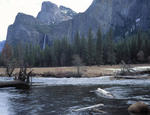A. It's a high quality build, but it's a nuclear dust magnet.
B. There is distinct fisheyeing, so to speak, if one shoots at odd angles, but I don't have the computer/software mix (yet) to correct for lens distortion.
C. I don't like the fact that if one chooses the WA setting in-camera, it disables any and all zoom. You're stuck at 18mm which, if you're far away from your subject, w/a little sensor, makes things difficult.
D. No exterior threads means no polarizer. Grrrrr.......
E. It can create odd pink and green polygonic lens flares. There ARE non-threaded lens hoods available, but I haven't got one yet.
I decided to challenge myself on last weekend's trip to keep the WA on the entire time, come what may, and simply shoot around any difficulties or problems that might present. The camera was usually set to 'Dynamic', everything was shot in manual, and all photos here are PP'd jpegs, as my current (soon to be replaced) computer cannot easily handle LR, PS or DxO. All NR in camera was turned down to -2. The only thing I did to any of these was contrast adjustment, sharpening at times and a touch of backlight when it made sense.
I also shot all the daytime shots using the EVF available for the LX5, which is GREAT for bright light/wide open spaces, but it's small enough where one doesn't always see the lens flare until after having shot. It's a super framing tool, but it's not the be-all end-all answer to occluded LCD screens.
This is right next to a rather disgusting natural spring on the south end of the Owens Lake called "Dirty Socks". I include it only to show the flaring on the lens.

The best luck I've ever had at Owens Lake: beautiful clouds, the beginning of a Sierra Wave formation (the blacker clouds) AND an opportune alkaline dust storm. This is looking due east from a derelict PPG chemical plant on the west shore.

Mono Lake, from the southern shore. About 45 minutes from sundown, and maybe 30 minutes afterward. The colors were as they appear in the pics. It changes FAST there. For those who've been to the tufa reserve there, we walked in and I decided to hike west to get to to a grouping of tufas that I've seen for many years, but never bothered to walk out to. Took about 10 minutes, and it was WET from melted snow. It's the westernmost of the three major ones at the reserve.

I like this one because the tufas on the left are actually like hollow pipes, and the last light is caught within them.

During the short-lived Band of Venus period


Yeah, I know, if that tufa had a name....


A short dawn spent at Convict Lake, where no clouds emerged, so we left quickly. The reflection of the moon in the water was nice luck, though, since that part of the lake hadn't frozen over yet.

Finally, the Alabama Hills, where I need to spend a LOT more time, and will do so shortly with and w/out the WA.
Mobius Arch. I know, I know, it's a warhorse like the GG Bridge, so I decided to shoot it from a different angle, w/out Mt. Whitney in the background.



All in all, a useful tool, but a handicap if one had to use it all the time.
Edited 1 time(s). Last edit at 01/27/2011 06:09AM by tanngrisnir3.


